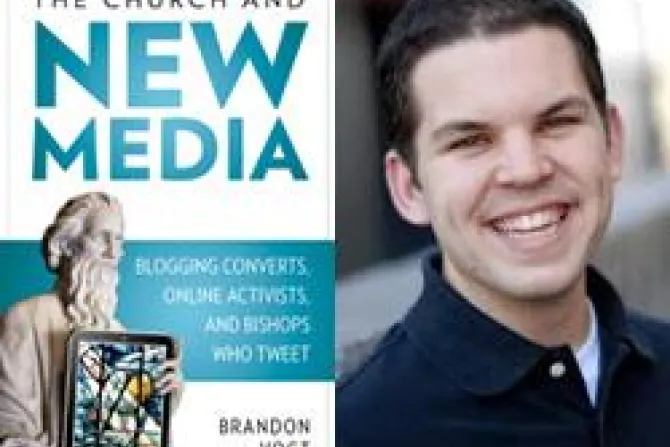Orlando, Fla., Oct 2, 2011 / 16:03 pm
Twenty-five-year-old author and Catholic convert Brandon Vogt has a message for the Church: utilize new media or fail to reach the American population and much of the rest of the world.
“These new media tools have already infiltrated our culture, our way of communication, in ways that are mind boggling,” Vogt told CNA on Sept.16.
“They are not a trend, they are not a passing fad and are therefore necessary for the Church to engage in,” he underscored.
“If this digital continent is where people are then the Church needs to be there too.”
In his new book, “The Church in the New Media” (Our Sunday Visitor/$13.95), Vogt describes a planet with over 750 million Facebook users, countless blogs and over three billion YouTube video views per day.
Last year, Americans alone sent over 1 trillion text messages and nearly 13 percent of online adults in the U.S. have Twitter accounts.
“I've seen intense, deep discussions about religion or faith or morals” on these mediums, Vogt said, “so I've seen the tip of the iceberg on how powerful these tools are.”
However, “when I look at the Church—especially her institutional arm as a whole—I saw that we were really not engaging these tools on any level compared to other spheres of life.”
Vogt estimates that the Catholic Church is “a good two to three years” behind most Protestant communities in using new media and when it comes to the secular world, “we're a good half decade behind.”
In writing his groundbreaking new book, Vogt said he wanted to use his own expertise and that of other online Catholics “to help the Church as a whole to engage this digital revolution.”
The book outlines what Vogt calls the four main uses the Church should have for new media: evangelization, faith formation, community building and mobilizing for the common good.
He marveled that for the first time in history, educating the faithful “is no longer a Sunday only activity or constrained to religious education classes.”
“We can really educate Catholics in their faith every second of every day—all the information is completely available 24 hours a day, seven days a week, 365 days a year.”
Aside from faith formation, however, Vogt said that the greatest area of potential for the Church is using new media for the common good.
“Catholic social teaching places a strong emphasis on the theme of solidarity. With these tools we have a primary chance to engage solidarity like we never have before.”
He cited the example of advocacy group 40 Days for Life, which has grown from a handful of people in a few short years to one of the biggest pro-life movements in the world.
(Story continues below)
“Anybody can connect with anybody in the world in a matter of seconds, especially for free, and so we can build movements for good.”
However, there are dangers to new media use, Vogt noted, explaining that more and more research is showing that the internet is actually rewiring the human brain, making us constantly distracted.
But he addressed the fear some have within the Church that Catholicism could be dumbed-down or reduced to sound bites through media tools.
“I don't think the danger is the competition between the distracted online culture and religion,” he said. Rather, “I think religion, Catholicism in particular, is the antidote to digital distraction.”
People in modern society are having an increasingly hard time engaging in deep, contemplative practices offline, Vogt said. And “I think that's the perfect pastoral opportunity for the Church.”
Through new media, he explained, the Church can point to ancient practices like Eucharistic adoration, contemplative prayer and lectio divina.
“The Church can come to these people and say, 'yeah, we know you're overwhelmed by this torrent of content online, we know that you're hungry for something deeper than the shallow Facebook messages and tweets you receive. Come to this fountain of depth and sustenance that the Church offers.'”
Vogt said that Catholics should take their cue from Pope Benedict, who recently made headlines when he tweeted for the first time.
“I thought it spoke monumental volumes to the world—I don't see any other major religious leader doing something like that.”
Although the Vatican has had some “tough love” moments in learning the need to stay current in their communication practices, the tweet “was a great sign of confirmation that the Vatican, from the very top, from our 84-year-old Pope, sees the value and importance of using these tools.”
But Vogt said he'd like to see more involvement in new media by U.S. bishops, many of whom may be intimidated by rapidly expanding technology and communication methods.
“It can be overwhelming with the new media tools because there are so many—even if you just look at the prominent ones, we're talking blogs, Facebook, Youtube and Twitter.”
Vogt recommends that bishops “just pick one that you're not doing and dive in—explore and test out different ways of posting and interacting with the commentators.”
He said that by engaging in new media, bishops have the power to alter young people's inaccurate perceptions of the Church.
“A lot of people my age, especially in the young adult generation, are disenfranchised with the Church for many reasons—one of which is they kind of picture the Church to be this distant, inhuman, disconnected organization,” he said.
“I think new media is the perfect way for bishops to change that perception. They can put a real face and real persona behind the Church's image.”
“This is a Church filled with real people, with real emotions and interactions.”
For those who are “still unsure, still hesitant, still fearful about engaging in the digital world because of all of its inherent dangers,” Vogt said, “I would echo the roar of Pope John Paul II—do not be afraid.”
“I think that is the voice that the Church needs to hear at this moment in time more than any other.”



